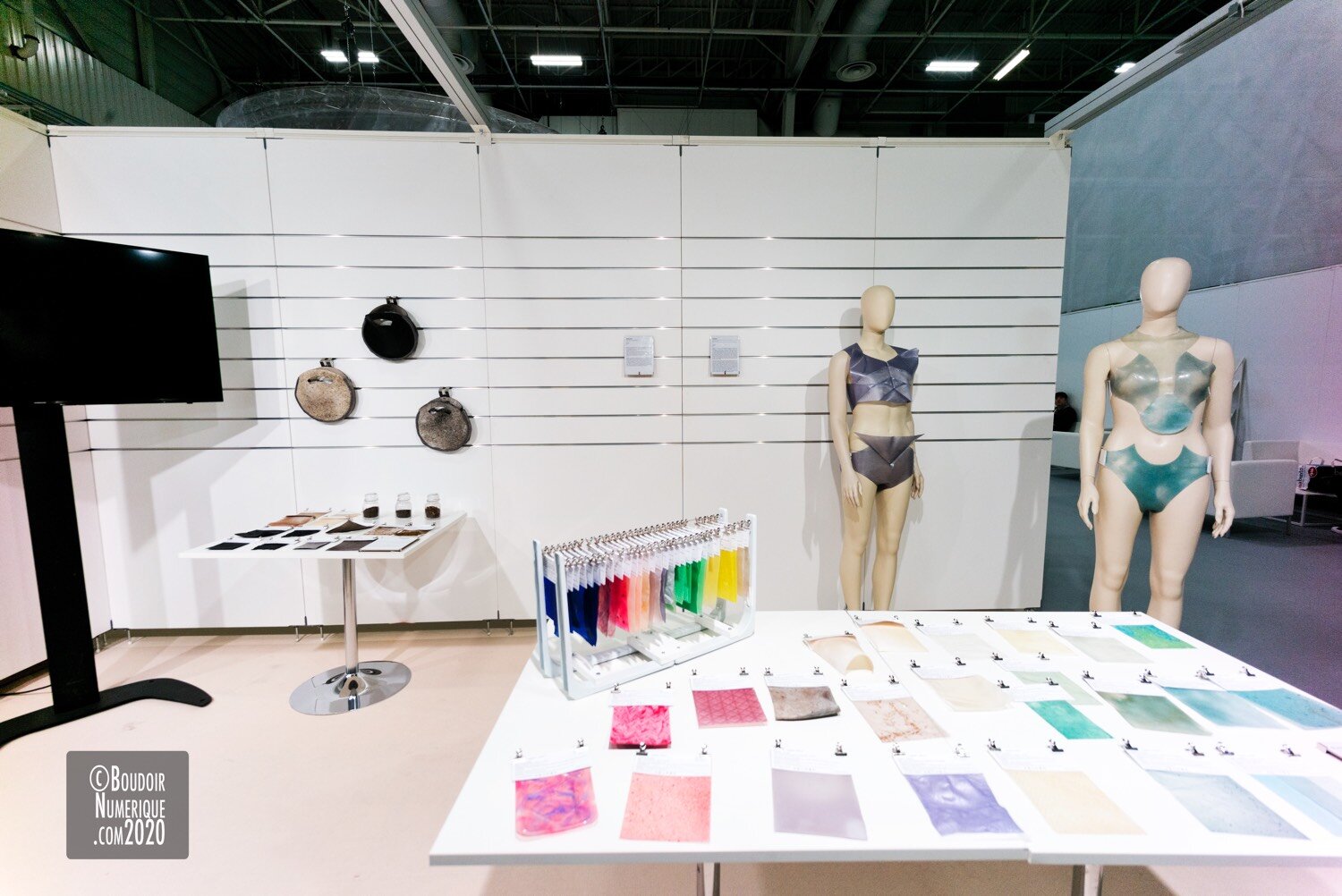Can we cook materials to make sustainable clothes and accessories? This is the mission chosen by the French-American textile designer Clara Davis. This specialist in biomaterials and technologies applied to fashion, met at Avantex last week, says more to Le Boudoir Numérique about her multidisciplinary DIY experiments, in search of durable design.
By Ludmilla Intravaia
Le Boudoir Numérique : Your Avantex stand is featuring several of your projects, the result of your research on biomaterials, such as Bioteca, a selection of bioplastics samples, from biological sources (see photos below). What is Bioteca ?
Clara Davis, textile designer : The bioplastics in my biomaterials archive were made with different biopolymers, derived from vegetal kingdom, such as agar-agar, sodium alginate and tapioca starch, as well as animal kingdom, such as collagen, a biopolymer obtained by boiling wasted meat industry and casein, a protein found in milk. My research on these bio-based, biodegradable and compostable materials began, in 2016, in the Fabtextiles department of the Fab Lab Barcelona, while I was thinking about my collection of bags Biobags, alternative to the traditional plastic bag, made of natural material that breaks down in nature. I started with gelatin, then I experimented, more and more, with other materials.
Why did you choose bioplastics ?
I have always been fascinated by plastic, its transparency, its color options, its thermoformable qualities and all the transformations that one can imagine with this material. As a designer, I love to create new things but the problem is that these new products have a negative effect on the environment. One should know that 80% of a product’s environmental impact is determined by its design. So the designer has the very important role of designing a product’s life with materials that match the ecological dimension. I am interested in biomaterials, because their use allows my creations to be more sustainable, more circular.
General view of Clara Davis stand, at Avantex, on February 10, 2020 (©Le Boudoir Numérique)
Do you grow your materials like the pioneering biodesigner Suzanne Lee? - to find out more, read this article from Le Boudoir Numérique on biofabrication, here -
No, I don't grow my materials, I cook them, according to different recipes, in the oven, in the pan or in a saucepan. It is a slightly different approach that allows you to have some control over the aesthetic appearance of the materials, depending on the final desired results. You can also use molds, which you could not be able to do, by cultivating your material. For example, I cook tapioca starch in the oven, using the same recipe but changing various parameters to obtain different textures. I can make the material transparent, by heating it on both sides or have a matte part and another shiny, by exposing it to the heat, just below. I work spontaneously, in a self-taught approach. I am imbued with this do it yourself culture, this desire to learn to understand the objects that surround us, in this philosophy specific to makers and those who are interested in design and art in the broad sense.
As a young multidisciplinary designer, do you work, for example, with electronic components, in a more specifically fashion tech perspective ?
I started with fashion tech a few years ago, with connected or luminous textiles and all the functionalities enhanced by electronics. The final project that I carried out for my Fabricademy courses at Fab Lab Barcelona was a garment that recharged, by jumping on it, without battery, just with the body energy. As, in parallel, I was researching biomaterials, I figured that there must be ways to create new augmented properties, not just through technology but also through biomaterials. How to do bioluminescence with bacteria, for example.
What is the purpose of all these experiments ?
What makes me dream is to develop clothes, whose functionality goes beyond the simple fact of being a garment, thanks to the materials that compose them. I want to go further, to increase the functionality of clothing by biomaterials which, for example, could improve skin elasticity and the micro-environment of the body. This is the case of my Calgina bodysuit (see photos below), made from sodium alginate, calcium chloride, spirulina and patchouli essential oil. This ecological biodegradable garment is designed to improve the well-being of the wearers, by optimizing their biological performance. Thanks to its materials that interact directly with the body, the Calgina bodysuit boosts the immune system, maintains hydration of the body, while promoting skin regeneration.
Finally, Avantex visitors could see your O-Trash² bags project (photos below)...
Yes, this is a collection of biodegradable bags, made from all the organic waste from my trash. This waste has been dried, crushed and filtered, and depending on the different filtration levels, various materials are obtained, with specific aesthetics. These bags take a week to decompose in nature or in compost.
Do you feel that your research is arousing public interest ?
The visitors of my stand seem very interested, indeed. I’m positive for the future, where exciting progress should come from the collaboration between designers and companies. I think we are on the right track.
* Clara Davis website is here, Fab Lab Barcelona website is here and Fabricademy Barcelona page is there.
General view of Avantex Agora, on February 10, 2020 (©Le Boudoir Numérique)
* The next edition of Avantex, the high-tech and innovative textile trade fair, will take place at Le Bourget, from February 10 to 13, 2020. More information on the event website here.
* Continue reading on Avantex with these following Boudoir Numérique papers :












